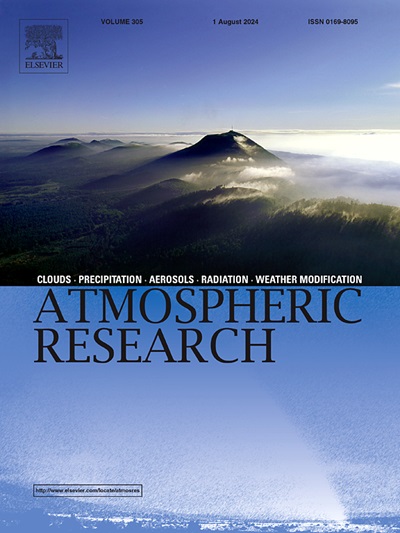垂直网格分辨率和湍流扩散不确定性对化学传输模型的作用
IF 4.5
2区 地球科学
Q1 METEOROLOGY & ATMOSPHERIC SCIENCES
引用次数: 0
摘要
化学传输模型(CTM)在模拟弱湍流扩散条件下的污染过程时往往表现不佳。在本研究中,我们从垂直网格分辨率和垂直混合方案的角度来解决这一问题。我们对 CHIMERE 模型的三种垂直网格分辨率配置(L4、L12 和 L40)进行了冬季评估,其中包括巴黎地区的一次重污染事件(PE)。结果强调了垂直网格分辨率的重要性,尤其是在夜间,因此影响了 CHIMERE 在夜间稳定条件下的模拟。根据简单的线性垂直扩散方案(定义为初始 Kz 扩散 (IKD) 方案),在细化垂直分辨率和第一层高度的情况下,CTM 建模得到了一致的改善。与其他两种配置相比,最精细的配置(称为 L4-IKD)在常规日(RD)的均方根误差平均分别提高了 23.26% 和 25.09%,在 PE 期间分别提高了 62% 和 129%。然而,使用基于 1.5 阶湍流动能(TKE)的涡扩散闭合方案(即新涡扩散(NED))进行的模拟对第一层高度设置更为敏感。过细的第一层高度会导致 TKE 计算不准确。一般来说,垂直网格分辨率较低的模型可以合理地预测 RD 或轻度污染事件期间的空气质量,但在重度 PE 情况下就很难预测了。一种直接的改进策略是在 CTM 模拟中增加一个额外的精细第一层高度,这样在 PE 期间,从 L4-IKD 到 L12-IKD 平均可提高 50.10%。另一种策略是增强模型的垂直扩散方案,在垂直网格分辨率相同的情况下,与 PE 期间的 IKD 相比,CTM 模拟提高了 26.67%。本文章由计算机程序翻译,如有差异,请以英文原文为准。

The role of vertical grid resolution and turbulent diffusion uncertainty on chemical transport modeling
Chemical transport models (CTM) tend to perform poorly in simulating pollution processes under weak turbulent diffusion conditions. In this study, we address this issue from the perspectives of vertical grid resolution and vertical mixing schemes. Three vertical grid resolution configurations (L4, L12, L40) with the CHIMERE model are evaluated during a winter episode, which includes a heavy pollution episode (PE) in the Paris region. The results emphasize the significance of vertical grid resolution, particularly noticeable during nighttime, and consequently impacts CHIMERE simulations under nocturnal stable conditions. Consistent improvement in CTM modeling is observed with refined vertical resolutions and the first layer height based on a simple linear vertical diffusion scheme defined as the initial Kz diffusion (IKD) scheme. Compared to the other two configurations, the finest configuration (referred to as L4-IKD) demonstrates an average improvement in root mean square error of 23.26 % and 25.09 % on regular days (RD) and 62 % and 129 % during PE, respectively. However, simulations using the 1.5-order turbulence kinetic energy (TKE) based eddy diffusivity closure scheme, named the new eddy diffusion (NED), are more sensitive to the first layer height setup. Excessively fine first-layer heights can lead to inaccurate TKE calculations. Generally, models with low vertical grid resolution can reasonably predict air quality on RD or during light pollution events but struggle with heavy PEs. One straightforward enhancement strategy involves adding an extra fine first layer height in CTM simulations, resulting in an average 50.10 % improvement from L4-IKD to L12-IKD during PE. Another strategy is enhancing the model's vertical diffusion scheme, which improved the CTM modeling by 26.67 % compared with IKD during PE under identical vertical grid resolution.
求助全文
通过发布文献求助,成功后即可免费获取论文全文。
去求助
来源期刊

Atmospheric Research
地学-气象与大气科学
CiteScore
9.40
自引率
10.90%
发文量
460
审稿时长
47 days
期刊介绍:
The journal publishes scientific papers (research papers, review articles, letters and notes) dealing with the part of the atmosphere where meteorological events occur. Attention is given to all processes extending from the earth surface to the tropopause, but special emphasis continues to be devoted to the physics of clouds, mesoscale meteorology and air pollution, i.e. atmospheric aerosols; microphysical processes; cloud dynamics and thermodynamics; numerical simulation, climatology, climate change and weather modification.
 求助内容:
求助内容: 应助结果提醒方式:
应助结果提醒方式:


